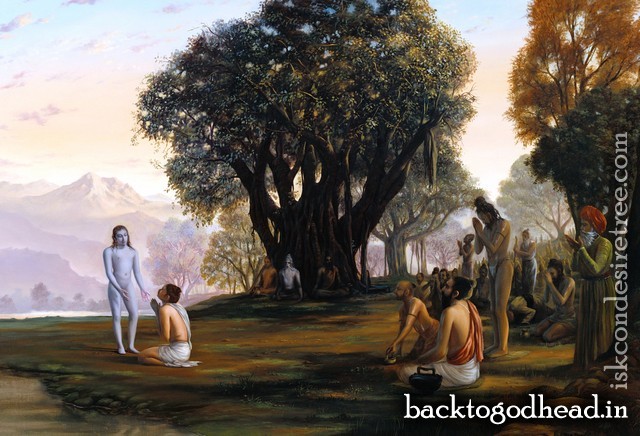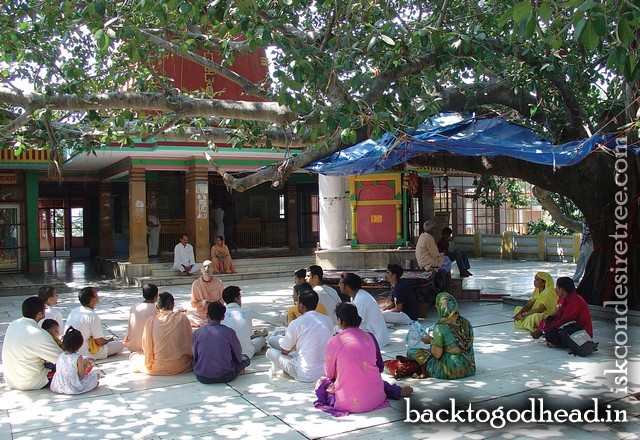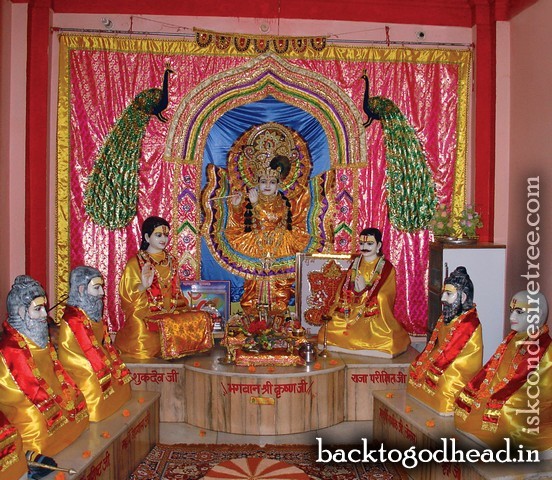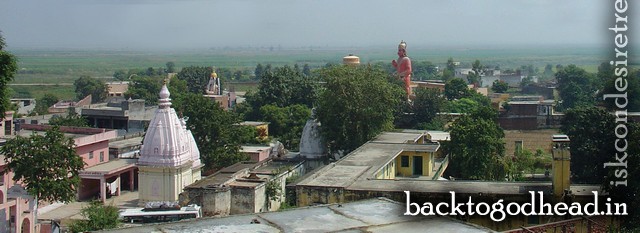The Site where Sukadeva Goswami Srimad-Bhagavatam brings to mind Caitanya Mahaprabhu’s contribution to our understanding of this great work.
We’ve com e to Sukatal to remember and glorify Sukadeva Goswami, Parikshit Maharaja, and Srimad- Bhagavatam. We will value Sukatal to the degree to which we have studied and developed appreciation for Srimad-Bhagavatam.
Suta Goswami began his narration of Srimad-Bhagavatam (1.2.2–3) to the sages at Naimisharanya by glorifying his spiritual master, Srila Sukadeva Goswami, who had spoken Srimad- Bhagavatam here to Parikshit Maharaja in the presence of great sages. Sukadeva Goswami, described as the guru of all those present, disclosed the message of the Bhagavatam the most confidential supplement to the Vedanta-sutra, considered the cream of Vedic knowledge. After having assimilated this knowledge, Sukadeva spoke out of great compassion for the materialists. Srila Vyasadeva described Srimad-Bhagavatam as the ripe fruit of the tree of Vedic knowledge, a fruit that became even sweeter when touched by the lips of (spoken by) Sukadeva Goswami.
Sukadeva came to speak the Bhagavatam at Sukatal because Parikshit Maharaja, the world emperor, was cursed to die within seven days by the bite of Taksaka, a snake-bird. Parikshit was cursed by the brahmana boy Srngi, who felt offended when Parikshit garlanded his father, Samika Muni, with a dead snake. (Since Parikshit’s behavior is unbecoming of a devotee, our acharyas have commented that the Lord arranged for Parikshit’s indiscretion, as it would lead to Sukadeva’s recitation of the Bhagavatam.) Although Maharaja Parikshit was powerful enough to counteract the brahmana boy’s curse, he accepted it as the Lord’s mercy to detach him from his home, wife, and kingdom and allow him to concentrate on his real interest in life: Krishna. Maharaja Parikshit’s response to the curse shows him to be a pure devotee of the Lord.
Parikshit Maharaja came here to the bank of the Ganges to fast till death. On hearing this news, many great sages traveled here from all over the universe. Maharaja Parikshit asked the sages, “What is the purpose of life, the unalloyed duty of everyone in all circumstances, and especially at the end of one’s life?” Some sages recommended that Maharaja Parikshit perform sacrifices, practice yoga, and give in charity. But he showed himself to be more spiritually advanced than these sages when he revealed his desire: “I pray that if I should again take my birth in the material world I will have complete attachment to the unlimited Lord Krishna, association with His devotees, and friendly relations with all living beings.”
The Recognized Leader of the Sages

Then the sixteen-year-old Sukadeva Goswami appeared on the scene. The powerful son of Vyasadeva, he traveled the world disinterested and satisfied within himself. He showed no signs of belonging to any social order or status of life. He was naked (digambaram: “clothed by the four directions”). He was handsome, with a bodily hue like that of Lord Krishna. By seeing his bodily features, the great sages present recognized him as a great personality. They greeted him by rising from their seats.
Maharaja Parikshit bowed his head to receive the chief guest, Sukadeva Goswami. Saintly sages and demigods surrounded Parikshit Maharaja, just as stars and other heavenly planets surround the moon. He recognized Sukadeva’s arrival as Krishna’s arrangement, so he asked Sukadeva the same questions he had asked the sages.
Sukadeva replied by speaking on the ten subjects of Srimad- Bhagavatam: the creation of the universe, subcreation, planetary systems, protection by the Lord, the creative impetus, the change of Manus, the science of God, returning home, back to Godhead, liberation, and the greatest good, or asraya. asraya means shelter. The ultimate subject of the Bhagavatam is Krishna-prema, love of Krishna. Krishna is visaya-vigraha, or the subject, making Him the object of prema. The asraya-vigraha is Srimati Radharani, the shelter of premaand therefore the subject of the Bhagavatam.
In Gopala Campu Srila Jiva Goswami writes that in Goloka Vrindavana, the abode of Krishna in the spiritual world, Sukadeva Goswami’s original form is that of one of Srimati Radharani’s pet parrots. Sukadeva came to Sukatal to speak the Bhagavatam, which describes Krishna, but he didn’t describe Radha. One reason for that is that he is Radharani’s parrot and She likes to hear about Krishna. Another reason is that to please Radha, Sukadeva wanted to engage souls (jivas) on earth in hearing about Krishna. All jivas are eternal servants of Krishna. A jiva who attains the highest position of serving Krishna comes under the shelter of Radha, because She knows how to serve Krishna best. Her very name means “the best servant of the Lord.” Because She serves Krishna best, we can serve Krishna best by assisting Her in Her service to Him.
The arrival of Sukadeva Goswami into the presence of Parikshit Maharaja is one of the greatest moments in the history of the universe, because devotees and philosophers came together to discuss Krishna. Nowadays “history” means mundane activities of the past, but the real history is given in Srimad- Bhagavatam, also known as the Bhagavata Purana. Therefore, an article describing Srila Bhaktisiddhanta Sarasvati Thakura’s visit to Sukatal (on December 23, 1930) was titled Paramarathik Bhugol o Itihas“Spiritual Geography and History.”
The Oldest Veda

Sukatal is always worth remembering and offering respects to because here Sukadeva Goswami spoke the Bhagavatam to Parikshit Maharaja. Although the Bhagavatam is listed as a Purana, it is the essence of all the Vedas. Some people believe that the four Vedas‰g, Sama, Yajur, and Atharvaare the oldest parts of the Vedic literature. But at the beginning of creation Lord Krishna spoke the catur-sloki (“four-verse”) Bhagavatam to Brahma, which makes Srimad-Bhagavatam the oldest. Since then it has been spoken throughout history in various forms. In its present form the Bhagavatam brings together various histories that show the supremacy of Lord Krishna. Srila Vyasadeva, after compiling and revising Srimad-Bhagavatam, taught it to his son, Sri Sukadeva Goswami, although his son was already self-realized. Vyasadeva knew that the Lord’s transcendental qualities can attract everyone, even persons free from material bondage. Such liberated persons develop the desire to render unalloyed devotional service, bhakti, unto the Personality of Godhead. This proves that Srimad- Bhagavatam, whose subjects are Krishna and bhakti, is transcendental, beyond the modes of material nature.
Sukadeva Goswami started by praising the questions posed by Parikshit Maharajaand not by discussing Radha-Krishna’s intimate rasa-lila because the answers to Parikshit’s questions point out the prime subject for hearing as approved by all transcendentalists. Such knowledge is of no interest to a materially engrossed person who spends his valuable lifetime only in sleeping, sex, making money, and maintaining his family. Sukadeva’s instruction that one must hear about, glorify, and remember the Personality of Godhead, irrespective of one’s path, is meant only for persons who desire freedom from all miseries. These instructions constitute our topmost duty.
Surprisingly, many assembled sages couldn’t answer Parikshit’s questions correctly and required Sukadeva Goswami to do so. Why? Because just being a transcendentalist is insufficient. Sukadeva Goswami himself exemplified this point. Vyasadeva knew that in the Bhagavatam’s teachings he had something to give that his selfrealized son could appreciate. So when Sukadeva left home, Vyasadeva had his disciples chant the Bhagavatam on the path where Sukadeva was walking. When Sukadeva heard the Bhagavatam, he felt an attraction to it. Because he wasn’t attracted to anything material, he could understand that this must be a spiritual attraction.
The Spotless Purana
Srimad-Bhagavatam is glorified as the spotless Purana because it does not promote dharma, artha, kama, and moksa: materially tinged religion, economic development, sense gratification, and liberation devoid of bhakti. These are generally considered desirable subjects for civilized persons. But the Bhagavatam tells us that any scripture or literature that does not clearly identify Krishna as the Supreme Personality of Godhead is rubbish, “a place of pilgrimage for crows.” Because Srimad-Bhagavatam leads one to Krishna the highest conclusion of all Vedic literature it is dear to Vaishnavas, who are seekers of the essence of things (sara-bhrtham). Srimad-Bhagavatam gives knowledge relished by the paramahaμsas, or transcendentalists. Its teachings are the perfection of renunciation, austerity, and detachment. Hence one should hear Srimad- Bhagavatam from a representative of Sukadeva Goswami. One should study it carefully and be blessed to go home, back to Godhead.
Lord Caitanya Reveals The Bhagavatam’s Essence

As I mentioned earlier, Srila Bhaktisiddhanta Sarasvati Thakura’s visit to Sukatal is described in the article Spiritual Geography and History. The author, Sri Sundarananda Vidyavinoda, quotes him as saying that although a great acharya can transmit the teachings of Sukadeva Goswami, Caitanya Mahaprabhu revealed the real essence of the Bhagavatam ujjvala-rasa, “splendid rasa,” or Krishna’s intimate relationships with His devotees. The Bhagavatam gives the highest philosophical exposition of the Absolute Truth, beginning with the four seed verses, and goes up to the gopi’s appreciating Krishna decorated with a peacock feather in His hair and looking like a stage actor, going out with the cowherd boys to the pastures, filling up the holes of His flute with transcendental sound, and so on.
Caitanya Mahaprabhu gave the ultimate essence of the Bhagavatam: the glories of Srimati Radharani. To readers of the Bhagavatam who don’t fully know the book, Radha is invisible there. Queen Kunti says that Krishna is invisible to the foolish and unintelligent. Caitanya Mahaprabhu came to give radha-mahima, the glories of Srimati Radharani, the sweetness of the sweet girls of Vrindavana, and entrance into their Vraja. That is Caitanya Mahaprabhu’s virahabhava, or mood of service in separation. His close associates Rupa Goswami and Svarupa Damodara Goswami understood His mood, and Rupa Goswami revealed it to others. We are known as Rupanuga Vaishnavas, followers of Rupa Goswami. He revealed that Caitanya Mahaprabhu is Krishna with radhabhava, the mood of Radha: He is Krishna hankering after Krishna.
A Suitable Place for Kirtana
The name Sukatal refers to a raised area where Sukadeva Goswami spoke the Bhagavatam. Tal means hill. A banyan tree marks the spot. A large festival takes place here during the month of Karttika. When Srila Bhaktisiddhanta Sarasvati Thakura came here, there was hardly anything here because of repeated flooding of the Ganges. People had left the area. Sundarananda Vidyavinoda wrote in his article that Bhaktisiddhanta Sarasvati Thakura came here because Sukatal lacked a proper speaker like Sukadeva. He also wanted to research the appearance of Sukatal and perform kirtana as recommended by Sukadeva Goswami in the last verse of Bhagavatam.
Bhakti Vikasa Swami, originally from England, is an ISKCON sannyasi, guru, and author. He spends most of his time in India, teaching Krishna consciousness.

